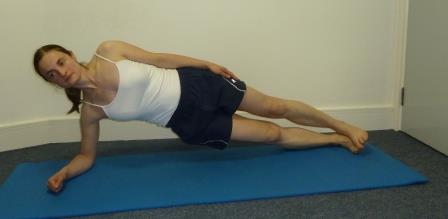Linking deficiencies in climbing performance to injury
From treating injured climbers in my clinic for the last 8 years, I’ve seen a pattern in the weakness observed which contributed to their injury.
Most of the injuries I see occur in the shoulder, elbow, wrist and hand, and the remainder are in the ankle due to falls or bad landings, the hamstrings (popping during heel hooks) and the lower back.
Some things pop out:
- The weaknesses seem to be there regardless of the grade the climber climbs.
- While some of these injuries are directly attributed to the sport e.g. finger pully injuries or ankle sprains, many are due to imbalances which build up due to things we do in our daily life like work/ study or other sports we are involved in. Daily life is the biggest influence on our body. Our body will adapt itself to the position it finds itself in for the most part of the day e.g. sitting if seated for work. To adapt some muscles shorten, others are on a stretch, some get stronger, some weaken. This imbalance creates an environment ripe for injury.
- When talking to climbers about the training they do, much of it is based on long standing types of training like finger boards, campus boards, pull ups (all for the arms), front lever, abs and plank for core. The training doesn’t always “balance” the body, for example, there is a strong focus on front lever or abdominal strength but there is very little focus on developing the lower back, gluteals, hamstrings which has implications in climbing – more below on this. We also need to keep in mind the way our body has adapted to daily life (point 2 above) and correct muscle imbalances that result from it.
So if you wanted to reduce the chance of injury or correct some muscular imbalances you have and improve climbing performance, what would you need to look at? I’m going to look at it from some common types of climbing moves / situations. If you don’t have the time to read on and would rather do a workshop on it, you are in luck, click here.
Improving Roof and Overhangs
The more body tension you have when on a roof or overhang the easier it is to climb and move through the roof. Ideally you need to avoid your bum sagging. When your bum sags it puts extra load on the arms to keep you on the holds increasing fatigue, as well as decreasing the reach you have to the next hold. If you think of gravity pushing you downwards causing your hips/pelvis/ bum to sag, then to avoid this you need to push back up through your hips and gluteals. These areas need to be strong but are frequently overlooked by climbers.
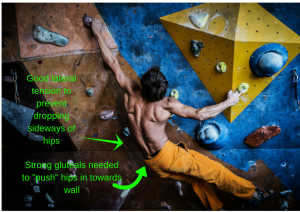
Strong abdominals and hip flexors are really important because they provide tension at the front of the body, but they need to be balanced by tension at the back of the body by strong gluteals and hamstrings (aka hip extensors). By working the front and the back of the hips & torso you form a sort of tension sandwich which is able to keep you from sagging down. You don’t fatigue as quickly, and you have more reach available to get to the next hold.
To check whether you have an imbalance between the abdominals / hip flexor and the gluteals / hamstrings, compare your ability to maintain a plank (front of body tension) versus a reverse plank (back of body tension). 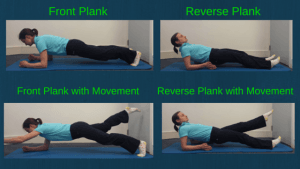 The reverse plank is the position you are in when climbing roofs. Many of you will find that your plank is a lot stronger than the reverse plank. Now try to move an arm or leg when in this position – note how much harder it feels to maintain your body tension.
The reverse plank is the position you are in when climbing roofs. Many of you will find that your plank is a lot stronger than the reverse plank. Now try to move an arm or leg when in this position – note how much harder it feels to maintain your body tension.
Where there is a muscular imbalance between the hip flexors and abdominals in the front, and the hip extensors in the back it can lead to changes in your posture and also back pain. Weakness here can also lead to increased chance of damaging the hamstring tendons when heel hooking, and weak gluteals are now known to be one of the main contributors to knee pain.
Twisting, Side Drop
Twisting motions come in part from the obliques (abdominal muscles to the side of the torso), so if you are on an overhang and cut free and have to twist your hips to get to a foothold out to the side, your obliques are strongly involved.
In the section above we looked at tension in the front and back of the body but we also need tension along our sides. This comes from a combination of strong oblique muscles and the hip abductors. Strong tension in our sides helps to regulate movements to the side but also rotational movements.
The side plank is an exercise where you can test your ability to maintain tension laterally.  Try it on both sides of the body and also see what happens when you move and arm or leg. In climbing body tension is required while moving limbs, so this would be a good test of your climbing specific body tension in this position.
Try it on both sides of the body and also see what happens when you move and arm or leg. In climbing body tension is required while moving limbs, so this would be a good test of your climbing specific body tension in this position.
Rotating the body, particularly the chest such as in cross-throughs is also dependent on the flexibility in the spine to allow the body rotate. If the mid to upper back is stiff (from work, posture, hunching over) then your range of motion here can be restricted leading to overreaching at the shoulder and incorrect shoulder movement which can result in shoulder, elbow and wrist pain.
Heel Hooks
Heel hooks put huge demand on the hamstrings and tendon injuries as a result of heel hooking occur. The pain will be felt along the tendons at the back of the knee or sometimes where the hamstring attach at the sit bones in the gluteal area. When I’ve assessed these climbers what is really noticeable is the weakness in their hamstrings and the gluteal muscle which work with the hamstring.
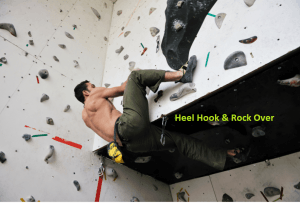
Dynos / High Step Ups
Both these moves require good leg strength. Hip flexibility also helps for high step ups. Strong quads (muscles in the front of the thigh) and gluteals really give power as a climber uncurls from the crouched dyno position. A strong core helps to transfer this power upwards towards the arms.
Regarding injury, as the knee is loaded and unloaded, we want to avoiding dipping of the knee inwards or outwards as this is an indication of muscle imbalance around the knee and the hip and can be a contributor of knee pain. For many climbers, knee pain is not an issue while climbing but more something they can be aware of when running, hiking or cycling. Occasionally climbers can tear cartilage in their knee, and may be aware of a pop or click when rocking over on a foot that is rotated out while the knee points inwards to the wall or rotates on the knee joint itself. In this case the pain can be severe, with swelling, a feeling of catching and often a sensation of the knee giving away.
Using your arms
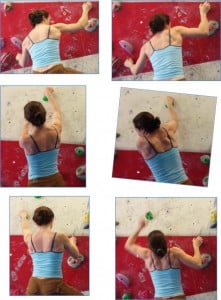
Comparison of Climbing Styles: Correct Shoulder Movement vs. Poor Shoulder Movement
Or more accurately not using your shoulder correctly…relying on the small muscles within the shoulder joint to pull or make a move, and not using the larger muscles in the upper back. As a result there can be an increased dependency on the arm (biceps extra) but more so the muscles in the forearm which leads to elbow and wrist pain.
I have written a detailed blog about shoulder movement and have tried to show examples of it. I would suggest checking it out as it’s way too much information to cover within this blog. But to simplify it, a climber who does not use their upper back enough when pulling will have a tendency to raise their shoulder towards the ear, and be less likely to climb with elbows in a plane parallel-ish to the wall. This changes the angle of the wrist at the climbing hold and stresses the muscles of the forearm and the elbow and wrist joints – see the climber on the right in the photos. Climbers using the upper back, tend to keep their shoulders away from their ears and would generally have their elbow more parallel to the wall. When pulling they tend to bring their shoulder blades in a downward manner towards the spine. This puts less strain through the wrist and elbow joints – see climber on the left in these photos.
Workshop
In conjunction with The Wall I am going to run a four 4 week class targeting key areas of weakness or muscle imbalance in climbers and strengthening these to reduce injury and improve climbing performance. It will start with a 1:1 assessment using key movement tests to identify any muscular imbalances which may make you prone to injury and then follow with a group strengthening class to over 4 weeks to address these. If you would like to find out more please click here.

